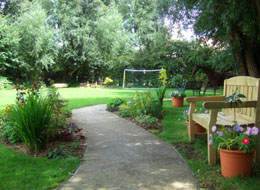If your garden does not receive adequate sunlight, then there is no need for despair. You can plan a garden for partial shade too. Here we will guide you on how to plan for a garden that receives partial shade.

A garden in your front yard is a wonderful way to make your property look more attractive. A well maintained garden can increase the curb appeal of your home and set it apart from the rest of the neighborhood. But what do you do if you have a garden that does not receive adequate sunlight and it is lined with big trees. Most plants require full sunlight to grow and flower, and shady spots can create difficulty in growing them. Proper selection of shade loving plants and a good garden layout can help you in creating a colorful garden in the shade.
Before we discuss garden plan for partial shade, it is important to understand what partial shade is. When an area of the garden receives 3-4 hours of the sun in the morning or late afternoon, it is referred to as an area that receives partial shade. The best plan of action in designing a garden that receives partial shade is to opt for annuals or hardy perennial plants that can thrive in partial shade. These type of plants are found in most nurseries, although you need to be knowledgeable about the kind of partial shade plants that you would prefer to plant.
Planning a Partial Shade Garden
To plan for a partial shade garden, first you need to prepare a layout for the garden. Once you have a layout ready, you need to make sure if this layout will work for your garden. Sometimes we make ambitious plans for landscaping a garden but it does not translate into what we have envisioned due to lack of space. Given below are some important aspects of planning a partial shade garden.
Decide on a Layout
One of the most important aspect in planning a partial shade garden is the layout of the garden. Avoid over formal layout for the garden as a natural meandering appearance looks more attractive in case of a shade garden. Design a layout that looks organic with different heights of bushes and shrubs nestled in rows to create demarcation. Flowering plants should be planted in flower beds that have a more informal shape like an oval or kidney shape for best results. Partial shade garden layouts that also incorporate the big trees that grows in the area, works well too. While designing a shade garden layout, it is best that you work with the natural slope of your property.
Decide on Garden Size
The size of the garden should be such that it is pleasing to the eye and it is in scale with the property. A very large shade garden is difficult to take care of, particularly if you are planning to do all the gardening work yourself. A 10 by 12 feet garden layout is big enough to allow you to come up with a great design but small enough for you to take care of the plants and flowers. The garden plan size for partial shade should be such that it appears proportional to the height and scale of the house.
Choose Shade Loving Plants
Of course, the key to a successful garden plan for partial shade is to choose the right shade loving plants. There is not much point in planning garden layouts and other garden accessories if the flowers and bushes that are planted in the garden fail to grow and bloom. Some of the best shade loving plants are red twig dogwood, impatiens, hydrangea and periwinkle. You can also choose Japanese pieris, fuchsia and ligularia. Another no-fail shade loving plant is hostas. Hostas comes in a variety of colors and textures which makes it an ideal plant to grow in a garden that receives partial sunlight.
Add Interesting Garden Accessory
To make your shade garden look more interesting, add a focal point to the garden by using beautiful garden accessories. A bird bath or a water fountain makes a wonderful addition to the garden. Plant a lovely flower bed or mid height bushes around the water feature to give the garden more pizazz. A small wooden bench and split rail fence can also be incorporated into the garden to add accent to the partial shade garden.
Coming up with a garden plan for a garden that receives partial sunlight is not difficult. Showcase flowering plants as well as bushes and shrubs that thrive in the shade. For a partial shade garden plan to be successful, you need to make sure that all the elements from plants, flower beds and garden accessories are in harmony.






 A garden in your front yard is a wonderful way to make your property look more attractive. A well maintained garden can increase the curb appeal of your home and set it apart from the rest of the neighborhood. But what do you do if you have a garden that does not receive adequate sunlight and it is lined with big trees. Most plants require full sunlight to grow and flower, and shady spots can create difficulty in growing them. Proper selection of shade loving plants and a good garden layout can help you in creating a colorful garden in the shade.
A garden in your front yard is a wonderful way to make your property look more attractive. A well maintained garden can increase the curb appeal of your home and set it apart from the rest of the neighborhood. But what do you do if you have a garden that does not receive adequate sunlight and it is lined with big trees. Most plants require full sunlight to grow and flower, and shady spots can create difficulty in growing them. Proper selection of shade loving plants and a good garden layout can help you in creating a colorful garden in the shade.